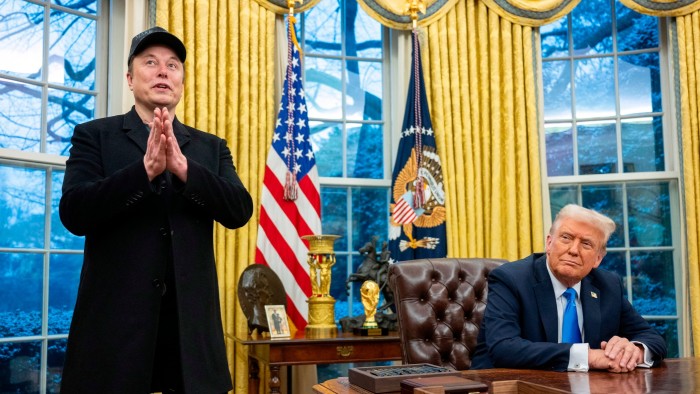Unlock the White House Watch newsletter for free
Your guide to what Trump’s second term means for Washington, business and the world
The writer is author of ‘Liberalism and Its Discontents’
The Trump administration came into office on January 20 vowing to destroy what it called the “deep state,” unleashing Elon Musk and his so-called Department of Government Efficiency on the federal bureaucracy. Musk proceeded to fire thousands of civil servants and close entire agencies with the purpose of eliminating “fraud, waste and abuse” in the US government, while saving taxpayers trillions of dollars.
Musk has since stepped down from Doge, having made an impact far more modest than he promised — indeed, he may in the end have done far more harm than good. Yet, his objective of making the US government more effective was essentially correct.
The Biden administration, having appropriated some $40bn to provide rural communities with high-speed internet, had not connected a single customer by the time it left office; California does not have high-speed rail 20 years after money was first appropriated, nor does the state seem to be able to solve its housing crisis that gives it the highest proportion of unsheltered homeless of any state in the union. The general sense that things don’t work the way they once did contributes directly to Americans’ enormous cynicism about government, and is one factor explaining Donald Trump’s popular support.
The reasons for this failure have been clearly outlined in Ezra Klein and Derek Thompson’s bestselling book Abundance, as well as Marc Dunkelman’s Why Nothing Works. They point out that America suffers from too many rules — rules that make it costly and time-consuming to build anything.
This wasn’t always the case. In the period beginning with the Progressive Era in the late 19th century up through the second world war, Americans thought of government as a force for good that could build infrastructure, win wars and land people on the Moon.
Beginning in the 1960s, however, activists on both the right and left increasingly saw the government as a negative force that was corrupt, captured or simply incompetent, one that had to be constrained by multiple layers of rules and procedures.
Consider one small example of excessive constraint. Unlike most other rich democracies, the US government and many individual states use what is called “private right of action” to enforce laws. The California Environmental Quality Act (CEQA) was passed in 1970, a law that grants standing to all 40mn residents of California to sue any project they want, public or private. The suits can be anonymous.
By one estimate, only 13 per cent of CEQA lawsuits are launched by environmental organisations; the rest are filed by business competitors, Nimby neighbours or labour unions. It is less an environmental law than a tool for extortion. In one recent case, the University of California at Berkeley wanted to add a few thousand students to their student body; the school’s upper middle class neighbours sued under CEQA on the grounds that the extra students would in effect constitute an environmental pollutant. A judge agreed, and the school’s expansion was blocked.
While it is usually conservatives who complain about excessive permitting, it was progressives who initially backed CEQA because they didn’t trust the government to enforce its own rules. This has led to the ironic result that building renewable energy infrastructure is being blocked by environmental regulations like CEQA that make it very hard to do things such as construct transmission lines or offshore wind farms.
In addition to permitting requirements imposed on private businesses, government is made inefficient by the layers of rules bureaucrats themselves are forced to labour under. A government agency cannot buy a desk or a computer without complying with the Federal Acquisition Regulations that spell out in thousands of pages the conditions which procurement officers must follow. Talk about waste.
According to Stanford law professor Daniel Ho, Congress has mandated that agencies file well over 5,000 annual reports, the vast majority of which nobody reads. Bureaucrats are incentivised to comply with these detailed and often pointless rules, rather than being allowed to use common sense and good judgment in applying legislative mandates.
Conservatives have been arguing for decades that we are living under a tyranny of “unelected bureaucrats” who make up rules on their own outside the control of democratically elected officials. The truth is rather the opposite: because America has a long history of distrusting government, we have added layer after layer of procedures that limit what officials can do.
If you want the government to be more efficient, you have to give them more authority to make decisions, not less. They have to be judged by the results they achieve for citizens, and not the rules they follow.
To be clear, I am not advocating the dismantling of the checks and balances built into the US constitution. These are more important than ever: the Trump administration has been violating the law virtually every day it has been in office, and these abuses of executive power must be stopped by the courts and ultimately by voters.
Instead, Congress and state legislators must pare back many of the accumulated procedures that block officials from flexibly carrying out their wishes. If government could actually spend its time implementing policies quickly and effectively, one of the motives for supporting populists like Trump could evaporate.
Indeed, opposition to Trump will not by itself propel his opponents into power. The Democrats need to put forward a positive vision for what the country could look like should they return to office. Many voters saw them as the party that presided over cities like San Francisco, Portland or New York, plagued by crime, homelessness and urban decay. Laying out a vision for a government that could return to undertaking grand projects once again is a hundred dollar bill lying on the sidewalk, waiting for an ambitious politician to pick up.
